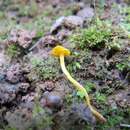en
names in breadcrumbs


Cantharellus minor is a fungus native to eastern North America.[1] It is one of the smallest of the genus Cantharellus, which includes other edible chanterelles. It is suspected of being mycorrhizal, found in association with oaks and moss.[1] Recently, C. minor has been reported from semi-evergreen to evergreen forests in the Western Ghats, Kerala, India forming ectomycorrhizal associations with tree species like Vateria indica, Diospyros malabarica, Hopea parviflora, and Myristica species.[2] The cap of C. minor ranges from 0.5 to 3.0 cm (0.2 to 1.2 in) wide and is convex and umbonate, often shallowly depressed, becoming funnel-shaped in some. The yellowish gills are decurrent, and fade to yellowish white in maturity.[2] The stipe is less than 4 cm (1.6 in) tall. They fruit in the summer and fall.[3] Although insubstantial, they are edible.[4]
Cantharellus minor is a fungus native to eastern North America. It is one of the smallest of the genus Cantharellus, which includes other edible chanterelles. It is suspected of being mycorrhizal, found in association with oaks and moss. Recently, C. minor has been reported from semi-evergreen to evergreen forests in the Western Ghats, Kerala, India forming ectomycorrhizal associations with tree species like Vateria indica, Diospyros malabarica, Hopea parviflora, and Myristica species. The cap of C. minor ranges from 0.5 to 3.0 cm (0.2 to 1.2 in) wide and is convex and umbonate, often shallowly depressed, becoming funnel-shaped in some. The yellowish gills are decurrent, and fade to yellowish white in maturity. The stipe is less than 4 cm (1.6 in) tall. They fruit in the summer and fall. Although insubstantial, they are edible.